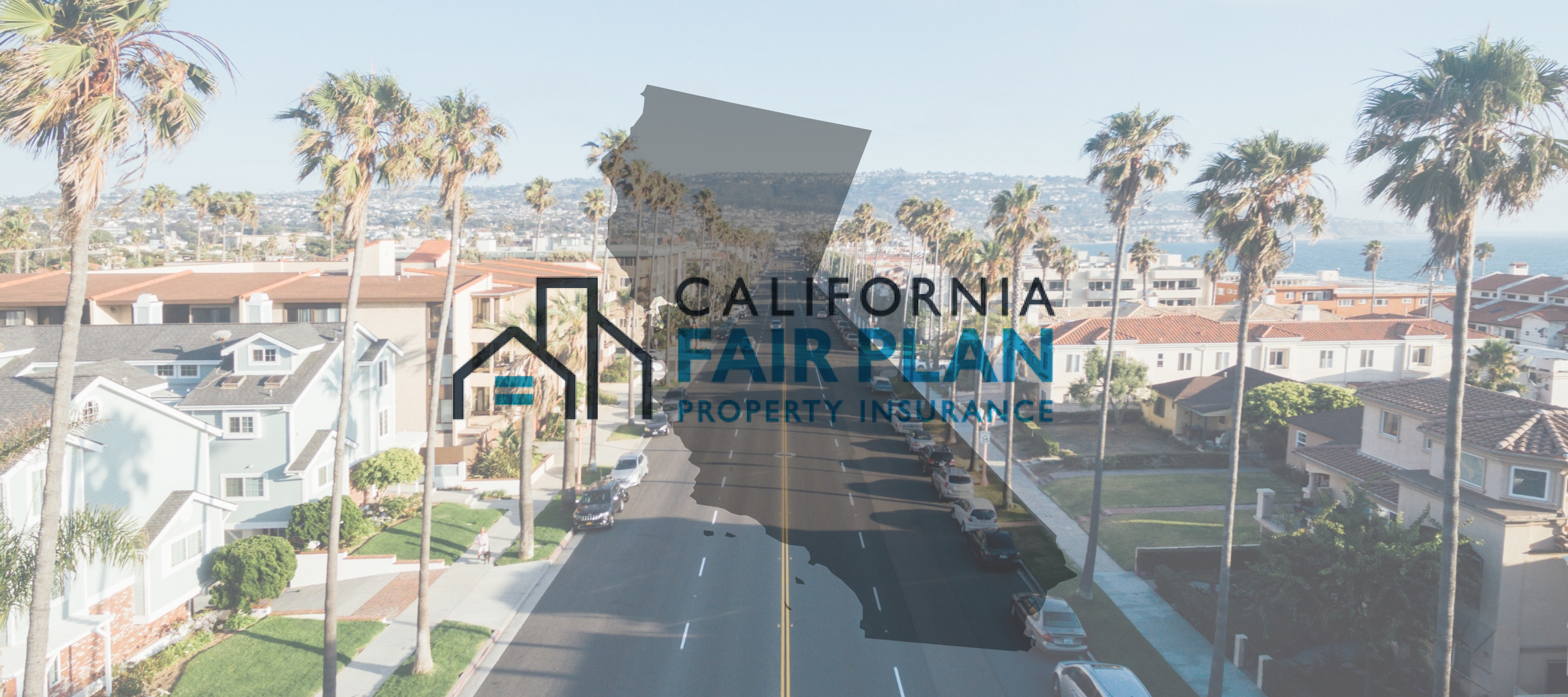In the dynamic landscape of commercial real estate, insuring residential-type properties like multifamily housing and apartment complexes can be challenging. For property owners navigating these complexities, the California FAIR Plan stands as an essential safety net, offering insurance when traditional coverage options fall short. This insurer of last resort should not be an afterthought but a strategic priority.
Let’s delve into how California FAIR Plan can protect your commercial real estate investments.
Eligibility Requirements
Commercial properties qualify for the California FAIR Plan when traditional insurance options are not available. Here are the key points regarding eligibility and the type of commercial properties covered under the California FAIR Plan:
Eligibility Determination
The FAIR Plan is considered as the insurer of last resort when a broker's diligent search in the traditional market fails, as defined by California Insurance Code section 10090 (d).
High-Risk Properties
The FAIR Plan is specifically designed to provide basic fire insurance coverage to high-risk properties across California, including those near brush or in wildfire-prone areas.
Understanding California FAIR Plan’s Insurance Offerings
The California FAIR Plan offers a range of coverage options for residential-style commercial properties, including multifamily units.
For example, Commercial Fire Policy provides named peril coverage for specific risks, such as vandalism, smoke, explosion, and vehicle collision, in addition to basic fire coverage.
It also offers options to purchase additional protection against wind, hail, explosion, riot or civil commotion, aircraft, vehicles, smoke, and volcanic eruption at an extra cost.
Commercial Property Types Covered
The California FAIR Plan covers a range of commercial properties including residential buildings with 5 or more units (e.g. apartment buildings, hotels, or motels), retail businesses (e.g. boutiques, salons, dry cleaners, convenience stores), manufacturers, professional offices (e.g. doctors, lawyers), new construction projects and basic property insurance for commercial farms, wineries, and ranches (excluding crops and livestock).
Deductibles and Premiums
It's important to note that while obtaining coverage through the FAIR Plan, the pricing remains consistent regardless of the broker you choose.
Program Expansions
The California FAIR Plan has evolved to enhance its offerings, as demonstrated by a November 2020 order requiring the addition of HO-3 policies to its existing fire-only coverage. This expansion broadened the scope of coverage to include water damage and personal liability.
Online Calculator
The FAIR Plan has a premium calculator on its official website to help policyholders estimate their premiums. It's important to note that the calculated amount is not a contract, binder, or offer of coverage, and an application must be submitted to the FAIR Plan to obtain an offer of coverage.
Financial Considerations
The FAIR Plan, despite its competitive rates given the high-risk nature of the properties it insures, has experienced rate increases. These increases are a response to the growing number of applications and claims, particularly those related to wildfire damage.
Rates and Deductibles
The FAIR Plan saw a rate increase of 15.6% effective from January 1, 2021, a reflection of the growing demand and increased risk associated with the properties it covers. Moreover, the average rate increase for policyholders can reach around 15%, varying heavily based on the wildfire exposure of the properties. Additionally, policyholders gained new deductible options of $15,000 and $20,000, offering more choices to manage insurance costs.
Rate Increases
Staying informed about potential rate hikes is crucial as they impact the overall insurance cost for commercial property owners. For instance, a significant request for a 48.8% increase in the dwelling-fire rate highlights the FAIR Plan's response to escalating risks and costs.
Quote Validity and Binding
To ensure continuous coverage without gaps, policyholders should confirm the validity period of their FAIR Plan quotes and bind the coverage before their current policy expires. Continuous communication with the FAIR Plan or your insurance broker is essential for efficiently managing your FAIR Plan coverage.
Given the high costs and limited coverage, it’s crucial to understand the financial implications, stay up-to-date on rate increases, and keep a transparent line of communication.
FAIR Plan Payment Options
Maintaining your coverage under the California FAIR Plan requires understanding the payment process. Here are the payment options available for your Commercial policy:
Online Payment Options
You can make payments online via checking or savings account, or credit card for Commercial policies.
Mail Payments
For policy payments, you can send your payment via mail to PO Box 76924, Los Angeles CA 90076-0924. Ensure that your policy number is clearly written on your check to facilitate accurate processing. If there's any change regarding your policy details, especially if your policy was written before 10/23/23, it's important to follow the provided link for updated information.
Retrieving Policy or Quotation Information
If you need to retrieve your policy or quotation information, follow the instructions provided on the payment portal.
For Quotations, enter the full Quotation Number as provided on the Payment Coupon, without spaces (e.g., “CFPQ0100018961”).
For Policies, enter the Policy Number as provided in the Payment Coupon, including spaces (e.g., “CFP 0100018953”).
Note: If a Policy Number has been issued, the Quotation Number cannot be used to process payment. Instead, use the issued Policy Number.
Claims Process
Navigating the claims process with the California FAIR Plan can be streamlined by following a structured approach. Here's a step-by-step guide on how to file a claim, followed by the documentation required, and the timeline for claims processing and settlement:
1. Immediate Action: In case of a loss, take immediate action to prevent further damage if safe to do so and report theft, vandalism, or malicious mischief to the police.
2. Contact FAIR Plan: Report the loss to the California FAIR Plan as soon as possible. You can report a claim by calling the California FAIR Plan Claims Department at 800-339-4099 or by visiting their website.
3. Claim Reporting Details: Provide your policy number, name, address, and the date and description of the loss. If possible, provide photographs and documentation to support your claim.
4. Adjuster Assignment: Once the claim is reported, a claim representative or an adjuster will be assigned to your case. The adjuster will contact you to discuss the loss and the claims process.
5. Inspection and Documentation: The adjuster may inspect the loss, take photographs, and gather necessary information. Keep all damaged property for the adjuster to inspect and provide all requested documentation.
6. Estimates and Evaluation: Obtain estimates for repair or replacement of damaged property through contractors and service providers. The adjuster will review the estimates and the documentation provided to evaluate the claim.
7. Claim Resolution: Once the evaluation is complete, the adjuster will discuss the settlement with you. Upon agreement, the settlement will be processed.
Documentation Required
The documentation required can vary based on the nature of the loss. Commonly required documentation includes:
-
Photographs of the damaged property.
-
Estimates for repair or replacement.
-
Police reports for theft, vandalism, or malicious mischief.
-
Any other documentation requested by the adjuster to support your claim.
Timeline for Claims Processing and Settlement
The timeline for claims processing and settlement can vary based on the complexity of the claim and the completeness of the documentation provided. We advise maintaining open communication with your assigned adjuster to stay updated on the progress of your claim.
The California Insurance Code requires claims to be acknowledged within 15 days after receipt, and the decision regarding acceptance or denial of a claim to be communicated to the claimant within 40 days after receipt of the claim. Further, upon acceptance, payment should be made within 30 days.
Customer Support and Resources
Contact Information for Customer Support
Policyholders can reach out to the California FAIR Plan customer service team via phone at 213-487-0111 or toll-free at 800-339-4099, Monday through Friday from 8:30 a.m. to 4:00 p.m.
For claims reporting, there is a 24/7 online claim reporting feature, or policyholders can call 800-339-4099 during business hours of 8:30 a.m. to 4:00 p.m., except on holidays.
For billing inquiries, policyholders can contact the billing department at 213-487-0111.
Online Resources for Policyholders
The official website www.cfpnet.com also hosts a page dedicated to policy information where policyholders can learn more about their coverage.
On the official website, policyholders can also access an online claim reporting feature, enabling them to report claims 24/7.
Additionally, there is a Policies page on the official website that provides more information regarding the policies offered by the California FAIR Plan.
Guiding Through the FAIR Plan with Advocate
The absence of private insurance options can pose significant challenges, especially for commercial residential property owners in California. Fortunately, the California FAIR Plan exists to provide a solution for properties that are unable to secure coverage in the private market.
Navigating the FAIR Plan may seem complex, but with a methodical and well-informed approach, the process becomes more manageable. This consolidated guideline aims to streamline the path for commercial property owners to obtain FAIR Plan coverage, ensuring that they are not left unprotected in a competitive and demanding market.


